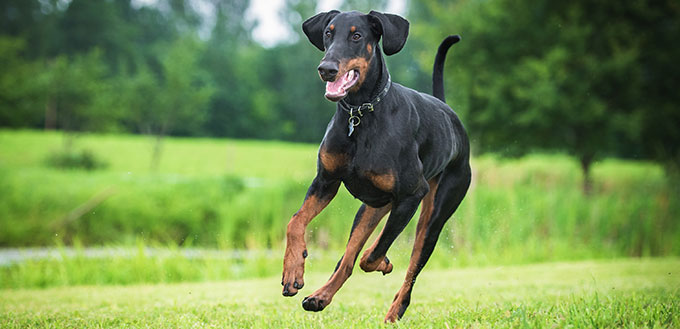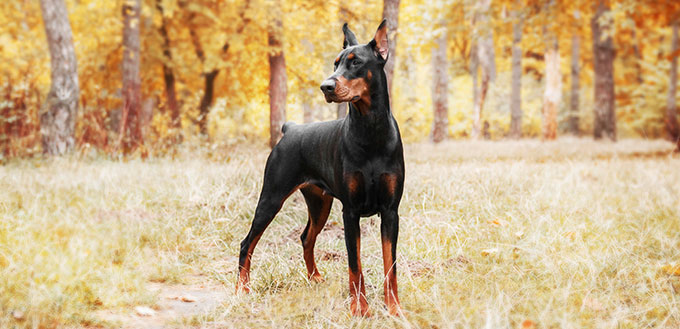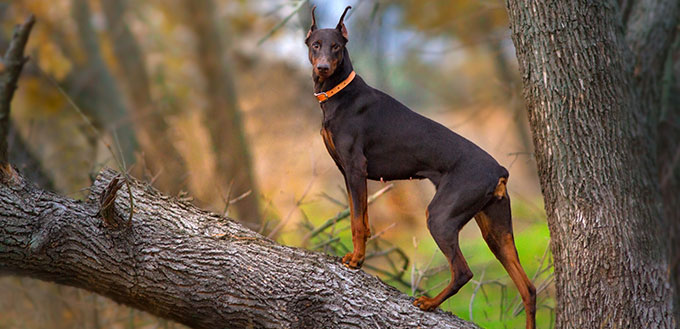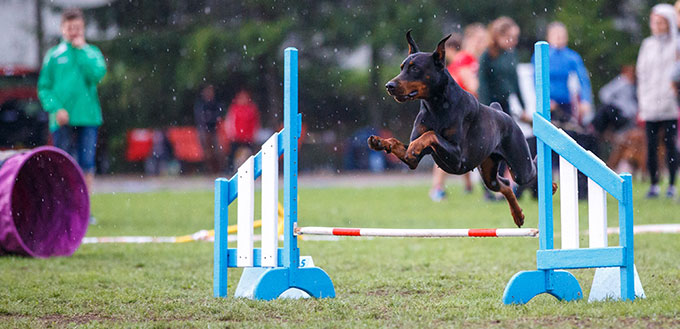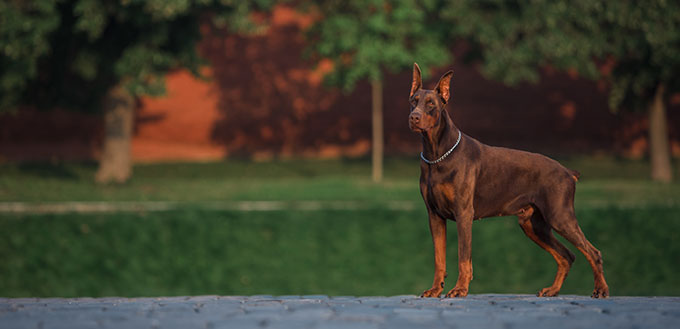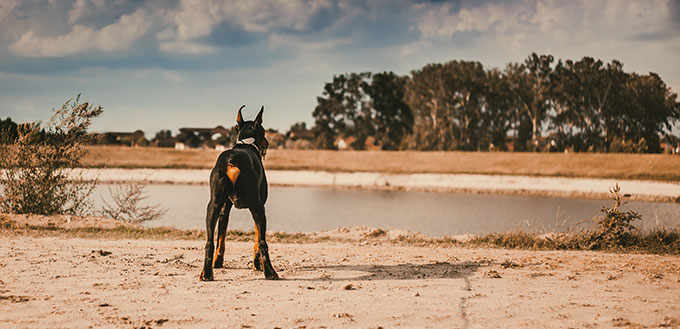Doberman Pinschers are an impressive breed, with beautiful, sleek, muscular bodies that are capable of very impressive things. Their use in the police force and military have given them the reputation of being an aggressive powerhouse, however, Dobermans can also be extremely sweet, loving, and loyal family pets when raised in an environment that nurtures socialization and uses domestic commands.
Much-loved throughout the United States, Dobermans are slowly breaking free of their vicious stereotype and showing the world their gentler side. So if you’re thinking of getting yourself a Doberman Pinscher, we hope that this overview will give you some of the key information you need to help you make a more informed decision.
Breed Overview
| Dog Breed Group | Height | Weight | Life Expectancy | Energy Level |
|---|---|---|---|---|
| Working Dog | 24 to 28 inches | 60 to 80 pounds | 10-13 years | Moderate |
History of the Doberman Pinscher
In the late 19th century, a man by the name of Louis Dobermann, who lived in the town of Apolda in Germany, had worked as the town dog catcher as well as a tax collector. Being a tax collector could be dangerous work and so he had often taken dogs with him as a form of protection. Dobermann eventually decided to begin breeding an ideal dog for companionship and protection, which resulted in the early Doberman Pinscher.
Dobermann had not kept any record of which breeds he had chosen to mix in order to create the Doberman Pinscher, however, study and speculation would suggest that the German Pinscher, Rottweiler, and Black and Tan Terrier had been key parts of the mix. Doberman introduced the “Dobie” in 1876 where the breed was met with great enthusiasm.
German breeders at the end of the 19th century, who had continued Dobermann’s work, had been more focused on the function of the breed as opposed to the appearance. The Doberman Pinscher was planned to be a “super dog”, Which meant only the quickest, bravest, toughest, and smartest dogs being bred together; but this choice backfired, as the resulting breed became aggressive and extremely headstrong.
Development continued on the breed with the help of a breeder named Otto Goeller, who was credited as being the one 12 have molded the Doberman into a more usable breed. The Doberman was later recognized by the German Kennel Club in 1900.
In 1908 the Dobie was brought to America and quickly gained a strong following which later became the Doberman Pinscher Club of America, founded in 1921; this was also when the breed standard was established, translated verbatim from the German standards they were established in 1900.
During WWI the Dobie population in Europe declined dramatically, due to people starving and being unable to afford to feed large dogs. Those who survived WWI were owned by the police, the military, and the wealthy, as breeding was considered a luxury. The decline of this beautiful breed in Europe continued through World War II, and it is believed that the breed was only saved by America taking so many Dobies to the United States during the earlier part of the century.
Few More Words About Doberman Pinscher
The recovery of the breed took many years following the two world wars. The word Pinscher was dropped from the name by Germany in the mid-1900s, and then by Britain who followed suit a few years later. Breeders have worked diligently over the years to soften the breed and filter out some of the more aggressive characteristics of their personality, with happy results. By working to blunt the Dobie’s sharp personality, these breeders succeeded in creating an affectionate, albeit protective, and loyal companion.
The Doberman is now a playful, hard-working, loyal, protective, and affectionate breed, which deserves to be recognized for the softer parts of its personality just as much as the harsher and more battle-ready side.
Breed Highlights
- Used for military and police work because they are reliable, powerful, and obedient.
- The Doberman Pinscher is a kind-natured breed with a bad reputation due to their aggressive career history.
- The Doberman is highly energetic and requires plenty of exercise, ideally one to two hours a day of walking.
- The Dobie will assume the alpha role in your household without a strong enough leader. Consistent training is critical in the early days to establish your role within the family as pack leader.
- To get a healthy dog, never buy a puppy from a puppy mill, irresponsible breeder, or pet store (Dobies are already at risk of multiple health complications even when purebred.)
Doberman Pinscher Breed Appearance
The body, color, and cut of a Doberman are what have given it its signature look recognized all over the world today. The American Kennel Club dog breed information regarding breed standards for the Doberman Pinscher are specific and unmistakable. If you are wanting to get yourself a purebred Doberman Pinscher, the knowledge of what people expect to see can help you to analyze a Doberman for yourself before purchasing or adopting.
Size
Doberman Pinscher dog breed is considered to be a medium to large-sized breed, measuring between 24 and 28 in height and weighing around 60 to 80 pounds by the time they are an adult. Their weight may be slightly disproportionate to their height, this is because Doberman Pinschers are extremely lean and muscular dogs, and muscle weighs more than fat.
Coat
Dobermans should have short smooth hair which is hard thick and close to the body, they do have a grey undercoat, however, this should be invisible. Turn off four colors that are allowed with Doberman Pinschers which are; Red, black, fawn (Isabella), and blue.
In terms of the markings expected to be seen in a Doberman’s coat, there needs to be a rust color, sharply defined above each eye, as well as on the muzzle, throat, fore chest, all legs and feet, and below the tail. The AKC also allows a white patch on the chest of their coat, but it cannot exceed half a square inch.
General Size and Build
They are a medium to large-sized breed expected to have a broad chest and well-tucked stomach. They are highly muscular dogs, with a lot of power in their rear legs for propelling themselves forward. Dobermans, as accepted by the AKC, are required to have their tail docked approximately at the second joint and the ears cropped so that they stand erect. If your Doberman is not docked or cropped they will have a long muscular tail and floppy ears, much like the German Pinscher.
Interesting Doberman Pinscher Facts
- A Doberman Pinscher by the name of Ch. Borong the Warlock is the most successful Doberman show dog in history, winning 3 American National Speciality shows along with at least 6 titles.
- A White Doberman Pinscher was bred in 1976 using the mutated albino gene, it is not recognized by the American Kennel Club for this reason.
- Their lean bodies make them highly sensitive to cold conditions.
- They naturally have long floppy ears and long muscular tails.
- Doberman Pinschers have been owned by many celebrities such as; Mariah Carey, Nicolas Cage, John F. Kennedy, Rudolph Valentino, Priscilla Presley, William Shatner, and Raquel Welch.
- Dobermans sometimes take part in the endurance test called Schutzhund, a test originally designed for German Shepherds.
The Doberman Pinscher Dog Breed Personality
The Doberman temperament and personality are quite different from what you might think when you consider the types of jobs they have been used for over the years. You may find yourself pleasantly surprised, as they are far more suited to domestic life than many people tend to assume.
Doberman Temperament
Much like humans, Dobermans personality can vary slightly from dog to dog; some may be shy and reserved, others may be more outgoing, B&B generally speaking Dobermans are known for being loyal, playful, friendly, protective, They can also have more dominant personality traits that can border on aggression, however, with the proper training and socialization this type of behavior can be avoided entirely.
The main misconception that we aim to break down is that Dobermans are not attack dogs, they are not vicious, and would never attack another completely out of the blue. Dobermans have a natural instinct to want to protect the ones they love from Intruders and are extremely loving companions, it is because of their military background that many people believe them to have a reputation as a violent dog breed, this is false, they have no more violent tendencies than any other dog breed.
Around Children
The Doberman Pinscher dog breed is trustworthy around children, family, and friends, and can make an excellent pet. Their protective nature can make them more reserved around strangers but encouragement to interact with anybody new that they meet can help them to get past their reservations. They love being a family pet and enjoy being closed with their loved ones, so long as younger children are taught to handle them with respect and care. Though this fact is true of any dog breed in a family setting.
Around Other Animals
If a Doberman puppy is brought into a household with pets they should grow to have no problems with them as they will have been socialized from the moment they enter the home, however, if you are bringing an adult dog into a home with other animals It would be well worth assessing their response to other pets before committing. Dobermans enjoy chasing small animals and if they are not socialized properly may become a real nuisance or source of stress to other pets in the house.
Entertainment
As it is with many highly intelligent dog breeds, Dobermans require a lot of entertainment throughout the day to stop them from becoming bored and potentially destructive. This doesn’t necessarily mean so you need to keep them engaged personally to every moment of the day, but rather that you need to be sure they have means to exercise their minds as well as their bodies in order to avoid them ripping up the carpet. here are a few of the better-known activities that can help with an intelligent dog’s restless energy:
Training: Teaching your dog how to follow commands provides them with plenty of mental stimulation, Training also has the possibility of providing them with the physical exertion needed to help them get through some of their excess energy.
Walks: A classic way to help any dog work through their pent-up energy is to take them out for a walk, Dobermans want one to two hours of walking time a day to avoid them getting the zoomies at night.
Puzzle toys: The perfect idea for any Doberman owner that is having to leave the house for long stretches of time would be to purchase a puzzle toy. Dog puzzle toys are the ideal way to keep your pup’s attention and exercise their mind, as well as help them with separation anxiety since their focus is being kept on something else and they are less likely to notice the time going by.
Dog Sports: Dobermans have high insurance and are fast, strong, and determined, with a high energy level, a perfect combination for dog sporting activities such as agility runs.
Quick Personality Facts
- They are naturally very protective of their family, hence their use as guards dogs and protection dogs.
- Dobermans are extremely loyal and enjoy being close to their owners and family.
- Early Socialization is essential for a more balanced and trusting dog.
- They are mistaken as aggressive but actually have a naturally more gentle temperament.
- They enjoy companionship and can struggle with separation anxiety if left alone for a long time.
Doberman Pinscher Care
Like any dog, the Doberman breed requires a good diet, plenty of exercise, grooming, interaction, and a loving family. But you must also ensure that you are well-read in regards to their more specific needs when it comes to dietary requirements, activity levels, stimulation, grooming needs, and overall pet care. We have broken down the most important areas of Doberman dog care to familiarise you is what you may expect should you choose to bring a Doberman Pinscher into your home.
Training
Dobermans are part of the working dog breed class, meaning they have an affinity for work and following commands. The biggest problem you may encounter when training your Doberman is that this is a stubborn breed, a common trait seen in many intelligent dog breeds. You will need to focus on finding a rhythm with them and bonding with your dog in order to develop a trust that can help you to strengthen your teamwork. Positive reinforcement is key in any basic training environment, so be sure to keep plenty of treats handy!
Obedience Training
Professional obedience trainers can show you the best method is for getting your dog to trust and understand you.
As previously established, the Intelligence of a Doberman can have a tendency to be a little bit problematic in the early stages of training. The best thing you can do with a stubborn and intelligent dog breed is taking them to obedience training classes.
The strengthened bond with your dog means if you chose to train them to be a family protector or guard dog you can feel confident in your ability to work together, this is crucial.
Training As a Protection Dog or Guard Dog
The Doberman Pinscher dog breed is considered one of the top choices for protection work as they have a reputation for their intelligence, loyalty, power, and response.
When it comes to training a Doberman Pinscher to be a protection dog or a guardian dog, it is vitally important that they have done exceptionally well during the obedience training stage. If when the obedience training is done they are not still completely committed to any instruction that they are giving without hesitation or argument, then your dog may not be suited to move forward to protection or guard duty.
It is possible to find Doberman breeders who provide young Dobermans that have been pre-trained as protection dogs for the first couple of years of their life by a protection and guard dog training Institute. This would be the best way to assure that your Doberman train as well as they possibly can be.
Work
Dobermans have a strong reputation for being great workers, hence their enlistment in the working dog category. And whilst they are better known for the more vigilant and aggressive jobs such as police dogs, and military dogs, they are actually considered a fantastic breed as therapy dogs as well.
Dobermans are naturally very stable friendly and outgoing dogs, it is their stability that has made them so trustworthy in the more difficult jobs, but also one of the main reasons that they can be trusted to support those who need it both children and adults. You quite often see Doberman dogs being kept in senior citizen homes as these calming and gentle traits can be extremely soothing.
Feeding
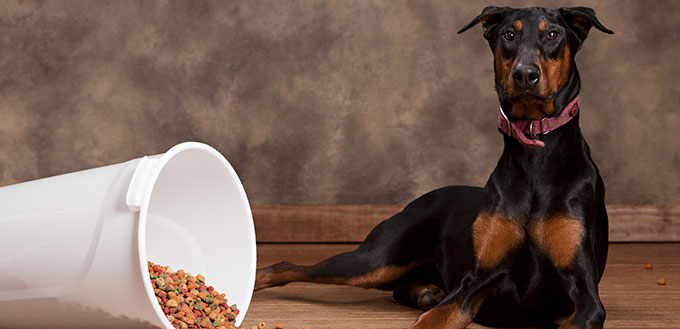 Doberman Pinschers need high-quality food which can help them to maintain healthy body weight. There is a good range of diets that can suit a Doberman Pinscher, but always be careful to follow the recommended amounts as stated by the food manufacturer.
Doberman Pinschers need high-quality food which can help them to maintain healthy body weight. There is a good range of diets that can suit a Doberman Pinscher, but always be careful to follow the recommended amounts as stated by the food manufacturer.
The Doberman Pinscher can vary quite dramatically in weight, so be sure to monitor them carefully as they grow to figure out your Doberman’s resting weight once they have fully matured. They are also very active and quite lean with a high metabolism, so ensuring they eat enough to hold a healthy weight is vital.
You May Also Like: Dog Food for Dobermans
Raw Dog Food
Doberman Pinschers, being lean and muscular dogs, need plenty of protein in their diet in order to help their bodies to recover after a long day. Raw feed diets provide a rich source of protein as well as giving you a dog a natural source of fat, calcium, and carbohydrates which are much easier for them to digest and easier for their bodies to process.
the only problem with this diet is that raw feed isn’t exactly cheap, making this easily the most expensive option. Even though the benefits of this diet far outweigh the negatives, it is not always feasible a full-time everyday option and so you may be drawn to finding a dry or wet food alternative.
Biscuits/Dry Kibble
The classic choice for most dog owners is to go with dry kibble or biscuits to provide their pup with all the necessary nutrients. The great thing with dry dog food is that the cost can vary greatly and cater to so many different budgets. Affordable doesn’t necessarily mean low quality, but if you are to go towards the more affordable end of the scale, you must be sure to check the ingredients as the cheapest foods can use unnecessary fillings and carbohydrates that provide no nutritional value for your pup.
So long as you select your brand carefully, your Doberman can live a very healthy and strong life on dry food alone, as good dry food can provide them with all the necessary protein, nutrients, and minerals they need to fuel their day.
Wet Dog Food
There are a few key points to consider if you are looking at perhaps using wet dog food for your Doberman Pinscher, and that is that wet food does not provide a crunchy texture and can contain gelatin and sugar as a preservative. Sugar is known for being bad for teeth, so if you keep a dog on wet food you must be sure to take care of their dental health to avoid problems in the future.
Wet food as a long-term diet can provide many of the benefits of raw food such as plenty of protein, natural fat, and nutrients for a balanced diet. However, be sure to check the fat content as well as the percentage of sugar used within the food. Though Doberman Pinschers may not gain weight very easily, an unbalanced diet can cause them to gain weight unnecessarily.
Which is Best?
Whichever diet you choose to go with, be sure to monitor your Doberman closely to start with to make sure that they do not have any allergic reactions, and that they are receiving the necessary amounts every day. A good way to know if a diet is working well is to watch their weight, as well as watching their general response to the food.
Grooming
Fortunately, Doberman Pinschers are low-maintenance dogs when it comes to their grooming needs! Bathing is very low on the list of priorities, owing to the fact that they have a short, sleek, coarse coat that will easily shake off general dirt, meaning you will only need to bathe your Doberman pinscher once every two to three months.
As is the case with every breed, you will need to make a point of cleaning your Doberman’s ears to avoid ear infections, as well as maintaining their claws. Doberman’s claws do not get overly long if they are walked regularly on a hard surface, however, any dog can end up with overgrown claws at some point during their life span, and knowing how to trim them properly is important for when you actually need to do it.
Take a look at our guides on Bath Tubs for Dogs, Dog Shampoo, Dog Nail Clippers, Dog Grooming Clippers, and Dog Ear Cleaners.
Managing Shedding
Much like with bathing, Doberman Pinschers coat does not require brushing all too regularly, because the smooth shiny texture of their coat means that loose fur is able to fall out with ease, requiring minimal assistance. if their fur is looking noticeably disheveled, brushing may be necessary, otherwise, you will only need to brush your Doberman Pinscher once or twice a month.
You may also like our articles on the Best Dog Shedding Brush and Best Brushes for Short Hair Dogs.
Health
Preparing the right pet care for your Doberman Pinscher when it comes to looking after their health is absolutely crucial if you are wanting to give them their best life. The Doberman is not considered a particularly unhealthy breed, in fact, Dobermans can live very long and happy lives, Without having to deal with any severe health conditions. However, they are definitely predisposed to a certain amount of health problems that need to be watched out for.
Understanding the potential health concerns your Doberman could develop can give you the foreknowledge to be able to spot symptoms during the early stages and get your dog the proper treatment before that particular health condition worsens.
Dobermans are particularly well known for their weakness towards heart disease, there are several heart problems that have been recognized as a cause for concern with Dobermans, so it is extremely important but every Doberman Pinscher undergoes annual heart testing to check for early signs of the following health conditions related to the heart:
- Cardiomyopathy
- Valve Disease
- Septal Defects
- Patent Ductus Arteriosus
- Pulmonic Stenosis
These are not the only health conditions Dobermans are known to suffer from however they are some of the most severe. The following health problems can also develop with Doberman Pinschers.
- Wobbler’s Syndrome: Dobermans are the second most likely breed (after the Great Dane) to suffer from Wobbler’s disease This is an intervertebral disc disease that affects the neck vertebrae causing compression of the nerves. This results in an unsteady or “wobbly” gait, limb weakness, pain, paralysis. This can be dealt with using both medication, and treatment as well as with surgical intervention.
- Von Willebrand’s Blood-Clotting Disease: This is a disease that affects around 30% of the breed on average, and can be carried by up to 50%. Fortunately, he can find out if your Doberman has the disease with a simple DNA test which can be carried out at any time.
- Hormonal/Endocrine System Diseases: This typically includes hyperthyroidism and diabetes. up to 20% of the Doberman breed requires daily supplements to keep on top of their low thyroid level.
- Eye Diseases: Eye diseases can include Retinal Dysplasia, Progressive Retinal Atrophy (PRA), Cataracts, Cherry Eye, and Entropion.
- Dental Disease: This can be decaying of the teeth, gum disease, tooth loss. It is important to keep on top of your dog’s dental hygiene whilst they are young to avoid any problems with their teeth when they are older.
Again, it is worth remembering that not all Dobermans are affected by the above health problems, but staying informed is always important. protecting their immune system with a healthy lifestyle can also go a long way to avoiding several of these health complications.
Exercising Your Doberman Pinscher
When you consider that a Doberman Pinschers is a lean, muscular, high-energy breed, you won’t be surprised to hear that they require a lot of exercise too. If a Doberman is left without exercise for too long they will begin acting out, typical examples of behavioral problems you might encounter if you do not exercise your Doberman properly are:
- Digging
- Chewing
- Barking
- Escaping
- Irritability
Pent-up energy in a Doberman Pinscher is something you would be best to avoid wherever possible, prolonged periods of no-exercise can also affect their mental health and cause depression if they feel cooped up and unable to run free, much like “cabin-fever”.
You will want to walk a Doberman Pinscher for 1-2 hours a day in order to work through their excess energy and give them a chance to stretch their legs and test their muscles. There are also several other activities you could do to test their paces and give them some more extensive exercise, some of these activities will also give them a chance to socialize more:
- Hiking
- Canine sports
- Agility training courses
- Endurance courses
- Biking or skating
- Jogging
- Give them an active job
It is important not to forget the activity level of your dog, no matter which breed you choose. Your Pinscher Doberman will thank you for the exercise you give it.
Adopt Don’t Shop
If you are able to, it is important that you consider adopting a Doberman pinscher instead of purchasing one. Because Dobermans can be temperamental and difficult to train many people can find their personalities overwhelming and are unable, or unwilling, to put the time and effort in that it takes to train a Doberman Pinscher properly. Because of this an unfortunate amount of Doberman Pinscher dogs find themselves in shelters with no home.
Every dog has its own story to tell, so if you decide to be the forever home for a Dobermann that has lost theirs, be sure to speak with the rescue or shelter at length regarding their past (if known) and any, illnesses, physical difficulties, or special requirements they may have before bringing them home to meet their new family.
Doberman Pinscher Rescues
- United Doberman Rescue
- Doberman Rescue of North Texas
- Doberman Underground Rescue
- Doberman Rescue of the Triad
- Doberman Pinscher & Little Paws Rescue
This list contains just a few of the amazing Dobermann Pinscher rescue groups that are located throughout the United States, these groups put in a tremendous amount of effort to create a solid rescue network that can dedicate time and energy to the rehabilitation and rehoming of Doberman Pinschers.
Reputable Breeders
Your best chance for finding a reputable breeder would be to take a look at the American Kennel Club marketplace. UK tea Market Place Screens and checks each one of the breeders before recommending them to the pub, meaning that if you choose to purchase a puppy from one of the breeders found on the American Kennel Club marketplace, you can be sure that these breeders have done everything properly and that the puppy you get will be in good health.
Additionally, your veterinarian or even a local Dobermann Pinscher Enthusiasts Club could help point you in the direction of a good breeder. Referral through one of these methods is more likely to point you towards a breeder that is humane and takes good care of their puppies before selling them.
Price
Doberman Pinscher puppies have an average price of around $1,000 but can vary greatly between $1,000 and $2,500 depending on the purity of the breed and where you are looking to purchase them from. If you find Doberman puppies for sale for less than $1,000 this could be a red flag, so just be careful to check all of their information before continuing.
First-year expenses tend to be a lot higher than the rest of their life owing to the fact that during their first year they will require more checkups, neutering or spaying, and vaccinations; as a result, their first year is estimated to be around $4,000, and then roughly $1,750 for every subsequent year (or $150 a month).
If you were to choose to adopt a Doberman Pinscher, the average price of adoption varies between $250 and $350. This is because every Dobermann Pinscher sold from a rescue has been through medical tests, vaccinations, and are neutered and spayed before they leave, the price you pay covers the cost of their care.
Additional Expenses
There are also additional lifetime and monthly expenses that must be considered when you are thinking of buying any dog, we have listed below some of the key expenses you can expect as a dog owner:
- Grooming
- A crate (if wanted)
- Monthly food cost
- Microchipping
- Toys and training equipment
- A collar and ID tag
- Food and water bowls
- Medical care
- Pet health insurance
- Treats
FAQs:
Q: Are Dobermans good guard dogs?
A: Yes. In fact, Dobermans are ranked amongst the top 5 breeds to be used as guard dogs alongside German Shepherd, Akitas, Rottweilers, and Bullmastiffs. They are extremely alert breeds and with the proper training can make the ideal guard dog for any home, because they also make great family dogs they are a good decision for anyone who is looking for a family companion and guard dog rolled into one.
Q: What is a Doberman Pinscher bite force?
A: The Doberman Pinscher breed has extremely powerful jaws, more powerful than a Pitbull or German Shepherd. When it comes to calculating the bite force of a Doberman Pinscher there are several factors to be considered such as; age, health, physical condition, and overall strength. There has been a multitude of studies conducted into the bite strength of a Doberman Pinscher, alongside other breeds of dog, and whilst the final figure can vary dependent on the above factors, there is an average bite force calculated at around 305 pounds per square inch ( aka 305psi).
Q: Can Doberman live in apartments?
A: It would be fair to assume that a Doberman Pinscher would not be well placed in an apartment owing to the fact that they are quite large and require a lot of exercise, where in fact they actually do perfectly fine in small living spaces like apartments and city homes. The main thing to remember if you are thinking of having a Doberman Pinscher in a smaller property is that additional care must be taken, throughout their lifespan, in providing them with the right amount of exercise if they have less space to roam at home.
Q: Are Doberman Pinschers hypoallergenic?
A: Unfortunately not, the Doberman dog is considered a poor choice for anybody who may struggle with dog allergies as their thick fur has been known to cause skin irritation.
Q: Do Dobermans attack their owners?
A: So long as a Doberman Pinscher is socialized properly at an early age and trained correctly, it will not show any aggression towards its owner. However, it is a typical personality characteristic of the breed for them to be mildly aggressive towards other canines, and potentially very aggressive towards strangers because of their suspicious nature. Though with the correct socialization, and persistence, this could be avoided as well.
Sources:
- Naomi Millburn, When Is a Doberman Pinscher Full Grown?, The Nest
- Doberman Pinscher, VCA Hospitals


